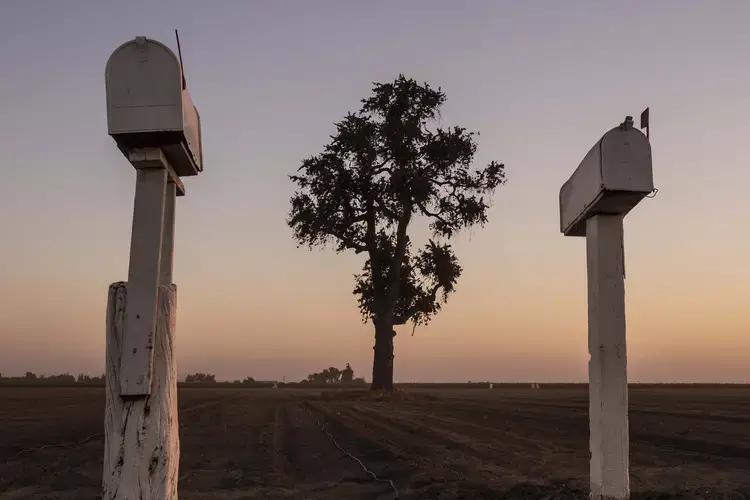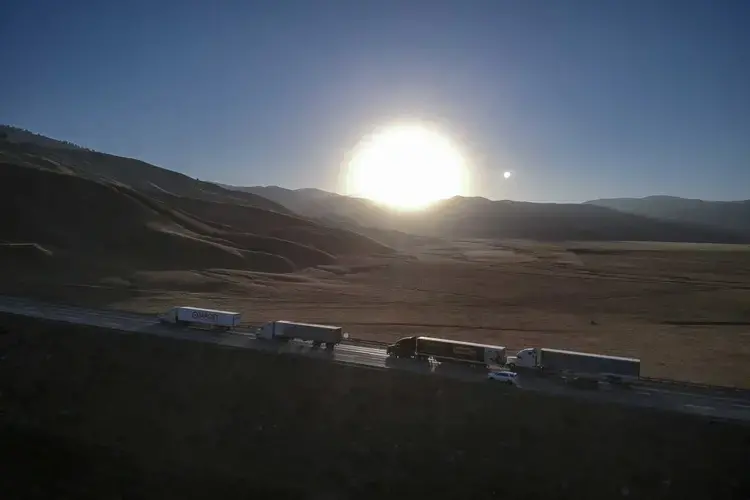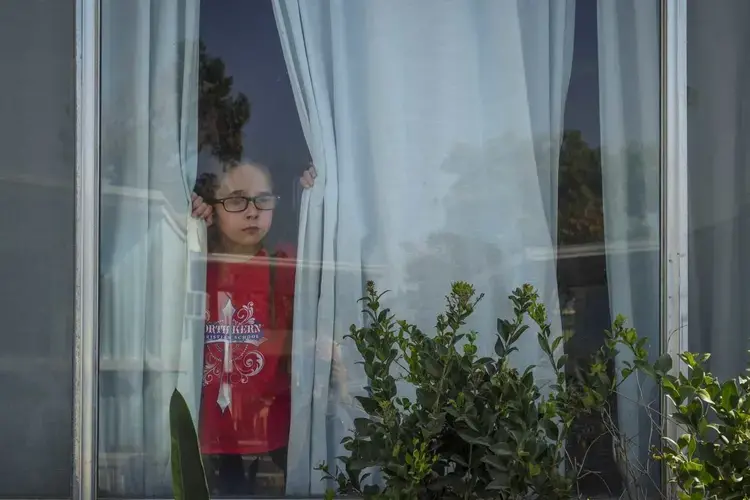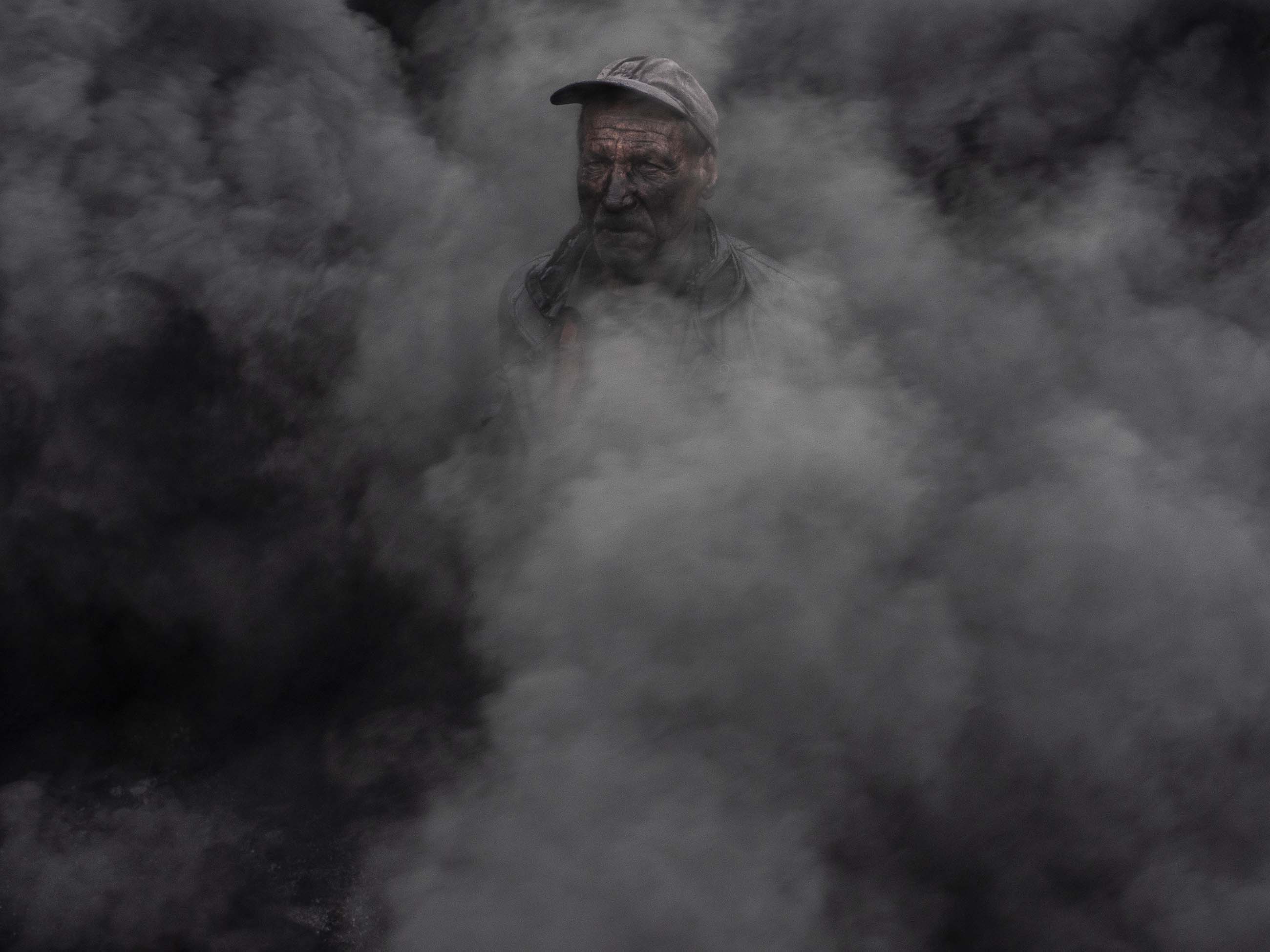
THE SAN JOAQUIN VALLEY is the land of Big Agriculture. Stretching 250 miles from Bakersfield in the south to Stockton in the north, the San Joaquin comprises the southern two-thirds of the storied Central Valley, a plowed-over promised land covering seven million acres of irrigated fields that generate more than $17 billion a year in crops — with the vast majority coming from three San Joaquin Valley counties. In sum, the region supplies a quarter of the food on American plates.
It is also awash in air pollution. Millions of beef and dairy cattle, millions of acres of dusty crops, and the truck traffic to support these mega-operations generate fine airborne particles that linger and swirl in what is, in effect, a gigantic, pollution-trapping bowl bounded by mountains. Add in prolific use of wood stoves and barbecue pits, the second-hand smog blowing into the valley from cities to the west and the north, and emissions from some of the densest oil fields in the lower 48 states, and the result is some of the worst air pollution in the nation.

California’s recent record-breaking forest fires only worsen the mix.
In Kern County, at the southern reaches of the valley, particulate pollution registers in the unhealthy range an average of 40 days a year, according to the American Lung Association’s (ALA) 2018 State of the Air Report. Concentrations of PM2.5 — microscopic particles 2.5 micrometers or less in diameter that can pass through the lungs into the bloodstream to cause respiratory problems, heart disease, and strokes — averaged 17 micrograms per cubic meter of air annually between 2015 and 2017, exceeding the U.S. Environmental Protection Agency’s annual target level of 12.
PM2.5, says John Bachmann, a former EPA official who helped develop the first national air quality standards for fine particles “appears to be the biggest source of air pollution-related health effects in the world.” The ALA attributes as many as 1,300 premature deaths each year to the noxious air here — alongside countless emergency room visits, lost days of school and work, and other public health impacts that cost the San Joaquin Valley as much as $11 billion each year. The problem is especially acute for the one in six children in the valley who the organization estimates now suffers from asthma.
It’s a burden that Shirley Hinslea, a resident of Kern County, knows well. Hinslea diligently checks for air quality information every day before deciding whether her 6-year-old daughter Kira, who suffers from severe asthma, can leave their home without a mask.
“It’s pretty bad,” she said, “when I can’t let her outside to play.”
A BOWL OF BAD AIR Although it doesn’t suffer from the type of air pollution experienced in parts of China and India, because of its unique geography and the proliferation of agriculture and industry, the San Joaquin Valley regularly experiences PM2.5 levels above EPA recommended thresholds. View the PM2.5 readings taken at a single location along Fishback Road in San Joaquin County over the course of 2017 on Undark.
STEVE BROWN of the National Oceanic and Atmospheric Administration’s Earth System Research Laboratory describes the valley’s most prominent pollution cocktail as a simple equation: “[It’s] cows plus cars,” he said.
At Harris Ranch, the largest feedlot in the valley, 100,000 head of cattle stand shoulder to shoulder under metal awnings on 800 barren acres surrounded by a chain-link fence topped with razor wire. Meanwhile, Harris Ranch trucks drive, collectively, 6,000 miles a day to haul upwards of 60 loads of feed to the cattle lots. Along their route through the valley, the trucks release nitrogen oxides (NOx) from their tailpipes, which react in the air to form nitric acid. Once in the air, molecules of nitric acid combine with molecules of ammonia gas rising from cow manure and urine on the feedlot to create ammonium nitrate. Ammonium nitrate, according to the California Air Resources Board, accounts for more than half of the region’s PM2.5 on the area’s most polluted days.
Efforts to curb the noxious chemical combination have a long history, and while strides have been made, progress has been slow and halting. Frank Mitloehner, an air quality specialist with the University of California, Davis who studies issues related to livestock production, suggested that dairymen can reduce ammonia emissions by feeding cattle a diet with optimal levels of protein — although that’s difficult to achieve because farmers tend to err on the side of overfeeding rather than run the risk of supplying the cows with too little protein. Better manure management, promoted in part by local regulations designed to reduce volatile organic compounds — a class of pollutants arising from all manner of products and processes, from paints and varnishes to cleaning solvents, fuels, cosmetics, and cow dung — has also reduced ammonia emissions per cow, according to Paul Sousa, director of environmental services and regulatory affairs with the Western United Dairymen, a trade association representing dairy farmers in California.
COWS PLUS CARS (AND OIL AND ALMONDS) In the the two short videos below, four sources of intense air pollution — including PM2.5 — are profiled. The first, an aerial overview of the region at work. The second, a series of 360-degree videos taken on the ground. Here, you can click and drag the video screen to explore the surrounding environment. (Click here to view the second video)
The San Joaquin Valley: An Air Pollution Overview from Undark Magazine on Vimeo.
SUCH ADAPTATIONS, however, are modest when compared to the size and scope of the overall pollution problem. John Capitman, the executive director of the Central Valley Health Policy Institute at California State University, Fresno and a member of the Governing Board of the San Joaquin Valley Air Pollution Control District, suggests that balancing pollution control regulations and the interests of businesses and farms is an ongoing battle. “Every place there is a technological fix,” Capitman said, “the tendency is not to insist on it unless there is an incentive.” (A proposed rule signed last month by EPA head Andrew Wheeler would exempt industrial farmers from reporting animal waste emissions to local communities, potentially providing them with even less motivation to tackle the problem.)
From 1998 to 2008, Harris Ranch tested out cleaner-burning natural gas trucks for hauling feed, but Patrick Smith, corporate transportation director for Harris, said the trucks were too heavy and the maintenance costs were a killer, so the ranch went back to diesel. A couple years ago, the company got a grant to try out an electric vehicle for work on the lot, but according to Smith, there was one software glitch after another at the start. “At the end of the day, we have to get our job done,” Smith says. “Or else we aren’t economically sustainable.”
Still, Smith adds that the company recognizes the impact that its operation has on air quality and is still considering replacing a third of its fleet with trucks fueled by low-emission natural gas, which emit only a tenth of the NOx produced by diesel-powered trucks. The company could receive about $2 million dollars from a combination of government grants and incentives to defray the cost of purchasing new, less polluting trucks, though that remains just a fraction of the total cost of such an ambitious substitution.
“We are trying to do our part,” Smith said.





CALIFORNIA ALSO produces 80 percent of the world’s almonds, most of which come from 900,000 acres in the eight counties of the San Joaquin Valley. During the harvest, convoys of farm machinery take to the orchards to shake the almonds from the trees and then blow and sweep the fallen nuts into piles, kicking up massive clouds of dust and debris in the process.
On an August afternoon, with the almond harvest in full swing at an orchard near Shafter, a city northwest of Bakersfield, the PM2.5 reading on a hand-held meter recorded 142 micrograms per cubic meter of air — four times the EPA’s daily standard. Overall, dust from farm activities and other disturbances accounts for up to 15 percent of the total PM2.5 in some parts of the region, according to data from the air resources board. Less dusty harvest methods exist, but they, too, require expensive investments in new machinery.
Almond trees become less productive after a certain age, so growers need to replace thousands of acres of old trees each year with new plantings. Traditionally, those trees would have been hauled into piles and set aflame. Air regulations in the valley had mostly eliminated that option by 2011, but weather conditions in recent years have forced officials to allow many farmers to burn again. Grinding old trees into wood chips and offsetting the cost by selling them to biomass energy companies to generate electricity has also grown more difficult due to increasing emphasis in the state on zero-emissions energy sources. Reincorporating wood chips into the soil can lead to more productive orchards and less pollution according to research conducted by the University of California Cooperative Extension, but costs as much as $1,000 an acre.
Heavy use of nitrogen fertilizer also contributes a third of the nitrogen oxides in California air, according to recent research in the journal Science Advances. And the San Joaquin Valley has some of the heaviest fertilizer use in the state.
Says almond grower Tom Frantz of the air pollution generated by his crop: “I don’t feel too good about it.”
HEMMED IN BY mountain ranges on three sides, the valley’s geography, and perhaps its politics, are at the root of both its fertility and its pollution troubles. In wintertime, a layer of warm air traps cooler, smog-filled air close to the ground, a phenomenon known as a temperature inversion. In addition to particle pollution, the toxic soup inhaled by valley residents also includes ozone and volatile organic compounds.
The San Joaquin Valley Air Pollution Control District estimates that 27 percent of emissions at the north end of the valley are blown in from the San Francisco Bay Area and the Sacramento Valley. Forest fires — California is currently experiencing the most destructive in its history — ratchet up the particulate pollution even more. And then there are the oil fields. From the lookout at Panorama Park in Bakersfield, hundreds of pumpjacks are visible bobbing up and down, some of them on properties abutting residential neighborhoods. With more than 9,000 wells on just 10,000 acres, the Kern River Oil Field is one of the densest in the nation, and Kern County as a whole accounts for about 70 percent of California’s oil production.
Most of the light oil has already been tapped over the last century, so San Joaquin Valley oil wells tend to produce some of the thickest, dirtiest petroleum in the nation. To bring up the more viscous remaining oil, drillers burn natural gas to create steam, which they inject into the wells. This process, according to the state emissions inventory, accounts for roughly 4 percent of the valley’s particulate pollution.
Still, while the southern part of the valley is less than 100 miles from downtown Los Angeles, its politics are more Kansas than California. Republican congressman Devin Nunes, a longtime global warming denier and foe of environmental regulation, just won re-election to represent a district that covers a large swath along the east side of the valley. Local regulators, meanwhile, historically have been sympathetic to agricultural interests.
Last year, Seyed Sadredin, who recently retired as head of the San Joaquin Valley Air Pollution Control District, went before Congress to ask for a reprieve for the valley from requirements of the Clean Air Act. Federal sanctions could have cost the region up to $2.5 billion in federal highway funds and fines, and new businesses would have been allowed to open or expand only if they could offset their emissions.
“If federal sanctions are imposed” Sadredin argued, “the impact will be devastating on valley residents.”




AMMONIUM NITRATE — that cows-plus-cars combination of ammonia emissions from manure and nitrogen oxides from tailpipes — remains the valley’s biggest problem. The San Joaquin Valley Air Pollution Control District argues that it makes more sense to regulate cars than cows. Local authorities, however, have limited power to rein-in nitrogen oxide emissions. Such regulations are largely the purview of state and federal governments, which set emissions standards for vehicles.
Nitrogen oxide emissions from passenger vehicles declined steadily in the 2000s, but then leveled off. About half of the NOx emissions in the district come from heavy-duty trucks. Although California implemented new rules for diesel truck emissions in 2012, only 29 percent of the fleet uses the cleanest technology. In a state with the strictest air quality rules in the nation, there’s still no smog check for big rigs.
The Air District could establish new emissions tests to force farmers to upgrade polluting tractors and other farm equipment that fall into their purview. Or it could restrict nitrogen fertilizer, which also produces NOx. But Manuel Cunha, a longtime agriculture lobbyist and head of the powerful Nisei Farmers League, argues that farmers can’t afford too many new regulations unless they are accompanied by taxpayer-funded subsidies. “You can have all the air you want, but if you don’t have food, what have you got?” he said. “You going to trust a third-world country for your food?”
It’s just one of the many tradeoffs that unfold year-in and year-out across this productive region — tradeoffs that leave Shirley Hinslea on the constant hunt for strategies to prevent her daughter Kira’s asthma attacks. The nonprofit Central California Asthma Collaborative recently installed an air monitor next to the family’s front door, so that Hinslea won’t have to rely on the Air District’s time-delayed data — gathered from a monitor about 25 miles away — to be delivered to her phone.
And yet, even as she worries about her daughter’s health, Hinslea — who was born and raised in the San Joaquin Valley — says she understands the difficult economic choices that animate the region.
“I grew up with farmers,” she said. “They have to have a livelihood.”
ALSO IN THIS SERIES:
Patna, India; Dhaka, Bangladesh; Southern Nigeria; Shijiazhuang, China
COMING SOON:
Santiago and Coyhaique, Chile; Macedonia.

Education Resource
Meet the Journalist: Larry C. Price
Award-winning documentary photographer and multimedia journalist Larry C. Price traveled the world...


















